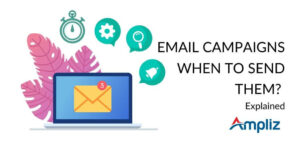Are you tired of the low open rates of emails you send to physicians and looking for best email marketing for pharmaceuticals companies?
Physicians being busy hardly get time to check their email boxes, and when they open they have hundreds of emails to check. So it’s very obvious to skip some unimportant emails. On top of that if your email is delivered other than inbox, then there is no chance that the physician will open it.
So what’s the solution?
The answer is to strategize your email marketing strategy. From writing the subject line to the main body of the email to the time of sending the email, everything is very important while implementing pharmaceuticals email marketing.
If you are keen to know how to strategize your next email marketing for pharmaceutical campaigns better, then this blog is for you. We are going to share tips that help you get more open rates, and engagement and increase your brand awareness among doctors.
Before we start with the strategy, let’s discuss why you should do email marketing dedicatedly to physicians. What are the benefits you will achieve?
Benefits of Email Marketing for Pharmaceuticals Industry
Email marketing is a gateway to hear yes in cold calling. Effectively done email marketing helps you reduce your sales around time and achieve your sales goal faster.
Email marketing helps you
- Creating brand awareness and positioning yourself as a great choice
- Create trust in them by delivering valuable content
- Get a great ROI
Now let’s discuss the email marketing strategies that help you get these benefits.
12 Effective Pharmaceutical Email Marketing Strategies
To take your pharmaceutical brand to the next level, email marketing is one of the best ways.
1. Choose the right email design
The structure and design of your email help it to stand out. The design of the email should be such that it should be readable and captivating for the reader.
For that, you should
- Write a short, crisp, compelling subject line
- Be purposeful with your layout
- Communicate effectively
- Write as you talk
- Give strong CTA
- The number of words in the email body should not be more than 250-300
2. Optimize for Mobiles
Optimizing emails for mobile devices is crucial in today’s digitally connected world, where the majority of people access their emails on smartphones or tablets. To ensure your emails are well-received and effectively engage recipients on mobiles, here are some creative and concise tips to optimize your email campaigns:
1. Responsive Design
Start with a responsive email design that adjusts seamlessly to different screen sizes. This ensures that your content looks great no matter what device it is viewed on.
2.Keep it Short and Snappy
Mobile users have limited attention spans, so get straight to the point. Craft concise subject lines that grab attention and use short paragraphs or bullet points for easy scanning.
3.Visible CTAs
Place clear, prominent call-to-action (CTA) buttons within thumb-friendly areas of the screen, making them easily clickable without zooming in or accidentally tapping other elements.
4. Font Size Matters
Opt for larger fonts (at least 14px) to enhance readability on smaller screens. Avoid fancy fonts that may not render correctly across all devices.
5. Good Visual Hierarchy
Organize content using an intuitive visual hierarchy with headings, subheadings, and contrasting font sizes/colors to guide readers’ eyes through important information effortlessly.
6. Images Optimization
Compress images without compromising quality to reduce load times while maintaining visual appeal—nobody wants slow-loading images to eat up their data allowance!
7. Avoid Tiny Buttons/Links
Ensure any interactive elements like buttons or links are large enough for easy tapping by fingers of varying sizes; this prevents accidental clicks and improves user experience.
8. Test Across Devices/Email Clients
Conduct thorough testing across various mobile devices and popular email clients (e.g., Gmail, Outlook) to identify potential rendering issues early on – you don’t want your beautiful design falling apart when viewed from different platforms.
3. Create Great Content
The purpose of email marketing is to build trust and build relationships with your clients. And this is possible only with the help of great content. The more value you share with your clients, the more they trust you.
That’s why you need to be very particular about sending emails to your clients. If you are just sending them promotional emails, then after some period of time they will stop opening your emails.
That’s why to keep engaging your clients you need to send them emails about various relevant research studies, clinical trial updates, and educational resources tailored to specific specialties or areas of interest.
This helps your clients update with the recent happenings.
4. Make sure your emails are deadly accurate
Check, edit, and proofread your emails before you hit the send button. Your target audience is physicians who are very particular about accuracy, so they expect the same from you as well. Any wrong statement or misinformation will spoil your reputation and reduce their trust in you.
5. Avoid spam folders
There are two main reasons behind your emails deliver to spam folders
- Wrong email addresses
- Your subscriber is not interested in your content anymore
Get rid of both factors.
Your email list should be accurate and updated. There should not be any faulty email addresses, old email addresses, or duplicate email addresses.
Many times subscribers either change the organization or field, and at that time the emails you send become irrelevant to them. At that time he doesn’t open your email. This lowers your email open rate and unnecessarily occupies the place. So it’s better to remove that subscriber from the list.
6. Send at the right time
If you don’t want your mail to get lost in hundreds of other emails, then you need to send the mail at the right time. For that, you need to first experiment and see at what time generally physicians open your email.
The best times, when they check their mail, are in the morning till 10 or 10:30, then during their lunchtime, and then in the evening. These times you should send the emails and check what exactly the times when they see your emails.
7. A/B test before sending
The success of your email marketing depends upon A/B testing. The more you test each element, the more you can measure it and the more you can improve it.
You can do A/B testing for the subject line, pretext, CTA, and even with the time of sending. With the help of A/B testing you can see which one of the two worked and which didn’t.
8. Write personalized emails
When it comes to writing personalized emails to physicians, you should follow certain guidelines to effectively communicate their message while maintaining professionalism and respect for the recipient’s time.
A. Subject line
The subject line should capture the physician’s attention and clearly convey the purpose of the email. A concise yet enticing subject line could be something like “Collaboration Opportunity: Improving Patient Outcomes.”
B. Greeting
Start your email with a polite greeting addressing the physician by their professional title, such as “Dear Dr. Smith” or “Good morning, Dr. Johnson.”
C. Introduction
Begin by briefly introducing yourself and your role as a pharmacist in relation to their practice or specific patients you both might share. This establishes a context from which you can build further engagement.
D. Personalization
Tailor your content based on relevant information about the physician or any previous interactions you may have had together, such as discussing shared professional interests or attending conferences together.
E. Clear purpose statement
State why you are reaching out and what specific topic/question you would like assistance with right at the beginning of your email body so that they can quickly understand its relevance.
F. Supporting evidence:
Provide succinct details about any recent research findings, clinical trials, drug updates, or other pertinent information related to your request/question that demonstrates how it aligns with their field of expertise and benefits patients’ well-being.
G i) Collaborative proposal/idea-sharing approach:
If seeking collaboration on a project or idea-related discussion:
- Clearly outline how working together will enhance patient care outcomes.
- Suggest concrete ways in which they can contribute (e.g., providing insights into potential medication interactions).
- Offer an open invitation for them to participate actively while ensuring flexibility regarding their availability.
G ii) Inquiry-based approach:
If seeking advice/guidance:
- Frame your inquiry as a specific question, seeking their expert opinion on a particular patient case or medication-related concern.
- Communicate that you value their unique perspective and expertise in decision-making, reinforcing the importance of collaboration between pharmacists and physicians.
9. Call to action
Clearly outline the next steps or any actions you would like them to take. This could be scheduling a meeting, reviewing attached materials, providing feedback through email or phone calls, etc.
10. Closing
End your email with an appreciation for their time and expertise. Offer assistance if they need any further information from you and express your willingness to discuss the matter further at their convenience.
11. Sign-off
Use an appropriate professional closing such as “Best regards,” “Sincerely,” or “Yours faithfully” followed by your full name, title/credentials (if applicable), contact information (phone number/email), and any relevant affiliations (e.g., hospital/pharmacy).
12. Analyze email campaign performance
You must check and assess certain matrix such as open rate, CTR, unique open rate, conversion rate, and so on. Based on it you can improve it.
Conclusion
Email marketing is one of the best and most effective marketing channels. It helps you make your own personal brand without relying upon any social media platform.
If done rightly, it can help you build trust and long-lasting relationships and skyrocket your business.



